Delineating Soil Management Zones for Site-Specific Nutrient Management in Cocoa Cultivation Areas with a Long History of Pesticide Usage
Abstract
1. Introduction
2. Materials and Methods
2.1. Description of the Study Area
2.2. Soil Sampling Regime and Laboratory Analysis
2.3. Data Analysis
2.3.1. Descriptive Statistics
2.3.2. Computation of Pollution Indices
2.3.3. Ordinary Kriging
2.3.4. Principal Component Analysis
2.3.5. Delineation of Soil Management Zones
3. Results
3.1. Characterization of the Studied Soil Properties
3.2. Relationship Between the Soil Properties and Heavy Metals
3.3. Spatial Distribution of Soil Properties and Heavy Metals
3.4. Principle Components Analysis (PCA)
3.5. Delineation of Management Zones Based on Clustering Analysis
4. Discussion
5. Conclusions
Author Contributions
Funding
Data Availability Statement
Conflicts of Interest
References
- Etaware, P.M. Some Identifiable Factors Responsible for the Variation in Cocoa Production in Nigeria and Other Cocoa Producing Nations, Adjudicated by Their Contributions to the Global Market. Front. Agron. 2022, 4, 731019. [Google Scholar] [CrossRef]
- WorldAtlas. The Top 10 Cocoa Producing Countries. 2020, p. 12. Available online: https://www.worldatlas.com (accessed on 12 June 2021).
- Prete, M.D.; Samoggia, A. Chocolate Consumption and Purchasing Behaviour Review: Research Issues and Insights for Future Research. Sustainability 2020, 12, 5586. [Google Scholar] [CrossRef]
- Wessel, M.; Quist-Wessel, P.M. Cocoa production in West Africa, a review and analysis of recent developments. NJAS Wagening. J. Life Sci. 2015, 74–75, 1–7. [Google Scholar] [CrossRef]
- Aminu, F.O.; Edun, T.A. Environmental effect of pesticide use by cocoa farmers in plantation soil in East Kolaka, Indonesia. Orient. J. Chem. 2019, 33, 1164–1170. [Google Scholar]
- Arham, Z.; Asmin, L.O.; Rosmini, R.; Nurdin, M. Heavy Metal Content of Cocoa Plantation Soil in East Kolaka, Indonesia. Orient J. Chem. 2017, 33, 1164–1170. [Google Scholar] [CrossRef]
- Aikpokpodion, P.E.; Adeniyi, D.O.; Olorunmota, R.T.; Adeji, A.O. Environmental Impacts of Long-Term Use of Pesticides in Cocoa Ecosystem. J. Res. For. Wildl. Environ. 2024, 16, 1–16. [Google Scholar]
- Yeboah, S.; Dogbatse, J.A.; Kumi, M.A.; Tulcan, R.X.S.; Addae-Wireko, L. Heavy metal status in cocoa (Theobroma cacao L.) soils and beans: The case of Abuakwa North Municipality of Eastern Region, Ghana. Environ Monit Assess. 2024, 196, 156. [Google Scholar] [CrossRef]
- Aikpokpodion, P.E.; Lajide, L.; Aiyesanmi, A.F. Heavy Metals Contamination in Fungicide Treated Cocoa Plantations in Cross River State, Nigeria. Am.-Eurasian J. Agric. Environ. Sci. 2010, 8, 268–274. [Google Scholar]
- Aikpokpodion, P.E. Assessment of heavy metals pollution in fungicide treated cocoa plantations in Ondo State, Nigeria. J. Appl. Biosci. 2010, 33, 2034–2046. [Google Scholar]
- Osinuga, O.A.; Aduloju, A.B.; Oyegoke, C.O. Impact of agrochemicals application on soil quality indicators and trace elements level of wetlands under different uses. J. Trace Elem. Miner. 2023, 5, 100090. [Google Scholar] [CrossRef]
- Isong, I.A.; John, K.; Okon, P.B.; Ogban, P.I.; Afu, S.M. Soil quality estimation using environmental covariates and predictive models: An example from tropical soils of Nigeria. Ecol. Process. 2022, 11, 66. [Google Scholar] [CrossRef]
- Amalu, U.C.; Isong, I.A. Status and spatial variability of soil properties in relation to fertilizer placement for intercrops in an oil palm plantation in Calabar, Nigeria. Niger. J. Crop Sci. 2018, 5, 58–72. [Google Scholar]
- Li, C.; Wang, X.; Qin, M. Spatial variability of soil nutrients in seasonal rivers: A case study from the Guo River Basin, China. PLoS ONE 2021, 16, e0248655. [Google Scholar] [CrossRef] [PubMed]
- John, K.; Bouslihim, Y.; Isong, I.A.; Lahcen, H.L.; Razouk, R.; Kebonye, N.M.; Agyeman, P.C.; Penížek, V.; Zádorová, T. Mapping soil nutrients via different covariates combinations: Theory and an example from Morocco. Ecol. Process. 2022, 11, 23. [Google Scholar] [CrossRef]
- John, K.; Isong, I.A.; Kebonye, N.M.; Ayito, E.O.; Agyeman, P.C.; Afu, S.M. Using Machine Learning Algorithms to Estimate Soil Organic Carbon Variability with Environmental Variables and Soil Nutrient Indicators in an Alluvial Soil. Land 2020, 9, 487. [Google Scholar] [CrossRef]
- Gökmen, V.; Sürücü, A.; Budak, M.; Bilgili, A.V. Modeling and mapping the spatial variability of soil micronutrients in the Tigris basin. J. King Saud Univ. Sci. 2023, 35, 102724. [Google Scholar] [CrossRef]
- Nyengere, J.; Okamoto, Y.; Funakawa, S.; Hitoshi Shinjo, H. Analysis of spatial heterogeneity of soil physicochemical properties in northern Malawi. Geoderma Reg. 2023, 35, e00733. [Google Scholar] [CrossRef]
- Yuan, Y.; Shi, B.; Yost, R.; Liu, X.; Tian, Y.; Zhu, Y.; Cao, W.; Cao, Q. Optimization of Management Zone Delineation for Precision Crop Management in an Intensive Farming System. Plants 2022, 11, 2611. [Google Scholar] [CrossRef]
- Lajili, A.; Cambouris, A.N.; Chokmani, K.; Duchemin, M.; Perron, I.; Zebarth, B.J.; Biswas, A.; Adamchuk, V.I. Analysis of Four Delineation Methods to Identify Potential Management Zones in a Commercial Potato Field in Eastern Canada. Agronomy 2021, 11, 432. [Google Scholar] [CrossRef]
- Aliyu, K.T.; Kamara, Y.A.; Jibrin, M.J.; Huising, E.J.; Shehu, M.B.; Adewopo, J.B.; Mohammed, B.I.; Solomon, R.; Adam, M.A.; Samndi, M.A. Delineation of Soil Fertility Management Zones for Site-specific Nutrient Management in the Maize Belt Region of Nigeria. Sustainability 2020, 12, 9010. [Google Scholar] [CrossRef]
- Ameer, S.; Cheema, M.J.M.; Khan, M.A.; Amjad, M.; Noor, M.; Wei, L. Delineation of nutrient management zones for precise fertilizer management in wheat crop using geo-statistical techniques. Soil Use Manag. 2022, 38, 1430–1445. [Google Scholar] [CrossRef]
- Behera, S.K.; Ravi, K.; Mathur, R.K.; Shukla, A.K.; Suresh, K.; Prakash, C. Spatial variability of soil properties and delineation of soil management zones of oil palm plantations grown in a hot and humid tropical region of southern India. CATENA 2018, 165, 251–259. [Google Scholar] [CrossRef]
- Zeraatpisheh, M.; Bakhshandeh, E.; Emadi, M.; Li, T.; Xu, M. Integration of PCA and Fuzzy Clustering for Delineation of Soil Management Zones and Cost-Efficiency Analysis in a Citrus Plantation. Sustainability 2020, 12, 5809. [Google Scholar] [CrossRef]
- Khan, H.; Farooque, A.A.; Acharya, B.; Abbas, F.; Esau, T.J.; Zaman, Q.U. Delineation of Management Zones for Site-Specific Information about Soil Fertility Characteristics through Proximal Sensing of Potato Fields. Agronomy 2020, 10, 1854. [Google Scholar] [CrossRef]
- Hashemi, S.E.; Gholian-Jouybari, F.; Hajiaghaei-Keshteli, M. A fuzzy C-means algorithm for optimizing data clustering. Expert Syst. Appl. 2023, 227, 120377. [Google Scholar] [CrossRef]
- Maleki, S.; Karimi, A.; Mousavi, A.; Kerry, R.; Taghizadeh-Mehrjardi, R. Delineation of Soil Management Zone Maps at the Regional Scale Using Machine Learning. Agronomy 2023, 13, 445. [Google Scholar] [CrossRef]
- Srinivasan, R.; Shashikumar, B.N.; Singh, S.K. Mapping of Soil Nutrient Variability and Delineating Site-Specific Management Zones Using Fuzzy Clustering Analysis in Eastern Coastal Region, India. J. Indian Soc. Remote Sens. 2022, 50, 533–547. [Google Scholar] [CrossRef]
- Gee, G.W.; Or, D. Particle Size Analysis. In Methods of Soil Analysis, Part 4, Physical Methods; Dane, J.H., Topp, G.C., Eds.; ASA and SSSA: Madison, WI, USA, 2002; pp. 255–293. [Google Scholar]
- Udo, E.J.; Ibia, T.O.; Ogunwale, J.A.; Ano, A.O.; Esu, I.E. Manual of Soil, Plan and Water Analyses; Sibon Books Limited: Lagos, Nigeria, 2009; p. 183. [Google Scholar]
- Nelson, O.W.; Sommers, L.E. Total Carbon, Organic Carbon and Organic Matter. In Methods of Soil Analysis Part 3, Chemical Methods; Sparks, O.L., Ed.; Soil Science Society of America Book Series Number 5; American Society of Agronomy: Madison, WI, USA, 1996; pp. 961–1010. [Google Scholar]
- Bremner, J.M. Total nitrogen. In Methods of Soil Analysis: Part 3—Chemical Methods; Soil Science Society of America, Inc.: Madison, WI, USA, 1996; pp. 1085–1121. [Google Scholar]
- Kuo, S. Phosphorus. In Methods of Soil Analysis: Part 3; Sparks, D.L., Ed.; SSSA Book Series No. 5; SSSA and ASA: Madison, WI, USA, 1996; pp. 869–919. [Google Scholar]
- Lindsay, W.L.; Norvell, W.A. Development of DTPA soil tests for Zn, Fe, Mn and Cu. Soil Sci. Soc. Am. J. 1978, 42, 421–428. [Google Scholar] [CrossRef]
- Hakanson, L. An ecological risk index for aquatic pollution control. A sedimentological approach. Water Res. 1980, 14, 975–1001. [Google Scholar] [CrossRef]
- Theoneste, N.; Gang, D.U.; Jing-Song, G.; Xu, G.; Lei, H. Pollution and potential ecological risk assessment of heavy metals in a lake. Pol. J. Environ. Stud. 2013, 122, 1129–1134. [Google Scholar]
- Goovaerts, P. Geostatistical modelling of uncertainty in soil science. Geoderma 2001, 103, 3–26. [Google Scholar] [CrossRef]
- Cambardella, C.A.; Moorman, T.B.; Novak, J.M.; Parkin, T.B.; Karlen, D.L.; Turco, R.F.; Konopka, A.E. Field-scale variability of soil properties in Central Iowa soils. Soil Sci. Soc. Am. J. 1994, 58, 1501–1511. [Google Scholar] [CrossRef]
- Andrews, S.S.; Mitchell, J.P.; Mancinelli, R.; Karlen, D.L.; Hartz, T.K.; Horwath, W.R.; Pettygrove, G.S.; Scow, K.M.; Munk, D.S. On-Farm assessment of soil quality in California’s central valley. Agron. J. 2002, 94, 12–23. [Google Scholar]
- Landon, J.R. Booker Tropical Soil Manual: A Handbook for Soil Survey and Agricultural Land Evaluation in the Tropics and Subtropics; Routledge: Oxfordshire, UK, 2014. [Google Scholar]
- Brady, N.C.; Weil, R.R. Elements of the Nature and Properties of Soil, 2nd ed.; Prentice Han: Englewood Cliffs, NJ, USA, 2006. [Google Scholar]
- Ambeager, A. Soil Fertility and Plant Nutrition in the Tropics and Subtropics; IFAV/IPI: Zug, Switzerland, 2006; p. 96. [Google Scholar]
- Lindsay, W. Chemical Equilibrai in Soils, 1st ed.; John Wiley and Sons: New York, NY, USA, 1979. [Google Scholar]
- Turekian, K.K.; Wedepohl, D.H. Distribution of the elements in some major units of the earth’s crust. Bull. Geol. Soc. Am. 1961, 72, 175–192. [Google Scholar] [CrossRef]
- Afu, M.S.; Isong, I.A.; Aki, E.E.; John, J. Heavy metals in agricultural soils developed on diverse parent materials in Cross River State, Nigeria. Arch. Agron. Soil Sci. 2021, 67, 1375–1387. [Google Scholar] [CrossRef]
- Gök, G.; Tulun, Ş.; Çelebi, H. Mapping of heavy metal pollution density and source distribution of campus soil using geographical information system. Sci Rep. 2024, 14, 29918. [Google Scholar] [CrossRef] [PubMed]
- Que, W.; Yi, L.; Wu, Y.; Li, Q. Analysis of heavy metals in sediments with different particle sizes and influencing factors in a mining area in Hunan Province. Sci. Rep. 2024, 14, 20318. [Google Scholar] [CrossRef]
- Paudel, M.; Adhikari, K.R.; Subedi, B.; Gairhe, J.J.; Vista, S.P.; Lamichhane, S. Assessment of the relationship between soil ph and macronutrients at Baseshwor, Sindhuli. J. Inst. Agric. Anim. Sci. 2020, 36, 241–248. [Google Scholar] [CrossRef]
- Aggag, A.M.; Alharbi, A. Spatial Analysis of Soil Properties and Site-Specific Management Zone Delineation for the South Hail Region, Saudi Arabia. Sustainability 2022, 14, 16209. [Google Scholar] [CrossRef]
- Salem, H.M.; Schott, L.R.; Piaskowski, J.; Chapagain, A.; Yost, J.L.; Brooks, E.; Kahl, K.; Johnson-Maynard, J. Evaluating Intra-Field Spatial Variability for Nutrient Management Zone Delineation through Geospatial Techniques and Multivariate Analysis. Sustainability 2024, 16, 645. [Google Scholar] [CrossRef]
- Akinbode, S.O.; Folorunso, O.; Olutoberu, T.S.; Olowokere, F.A.; Adebayo, M.; Azeez, S.O.; Hammed, S.G.; Busari, M.A. Farmers’ Perception and Practice of Soil Fertility Management and Conservation in the Era of Digital Soil Information Systems in Southwest Nigeria. Agriculture 2024, 14, 1182. [Google Scholar] [CrossRef]
- Afu, S.M.; Isong, I.A.; Olim, D.M.; Egbai, O.O.; Aaron, M.E.; Heueng, B.; John, K. The nexus of clay mineralogy and soil fertility under diverse parent materials in two distinct geomorphological settings. Environ. Earth Sci. 2024, 83, 653. [Google Scholar] [CrossRef]

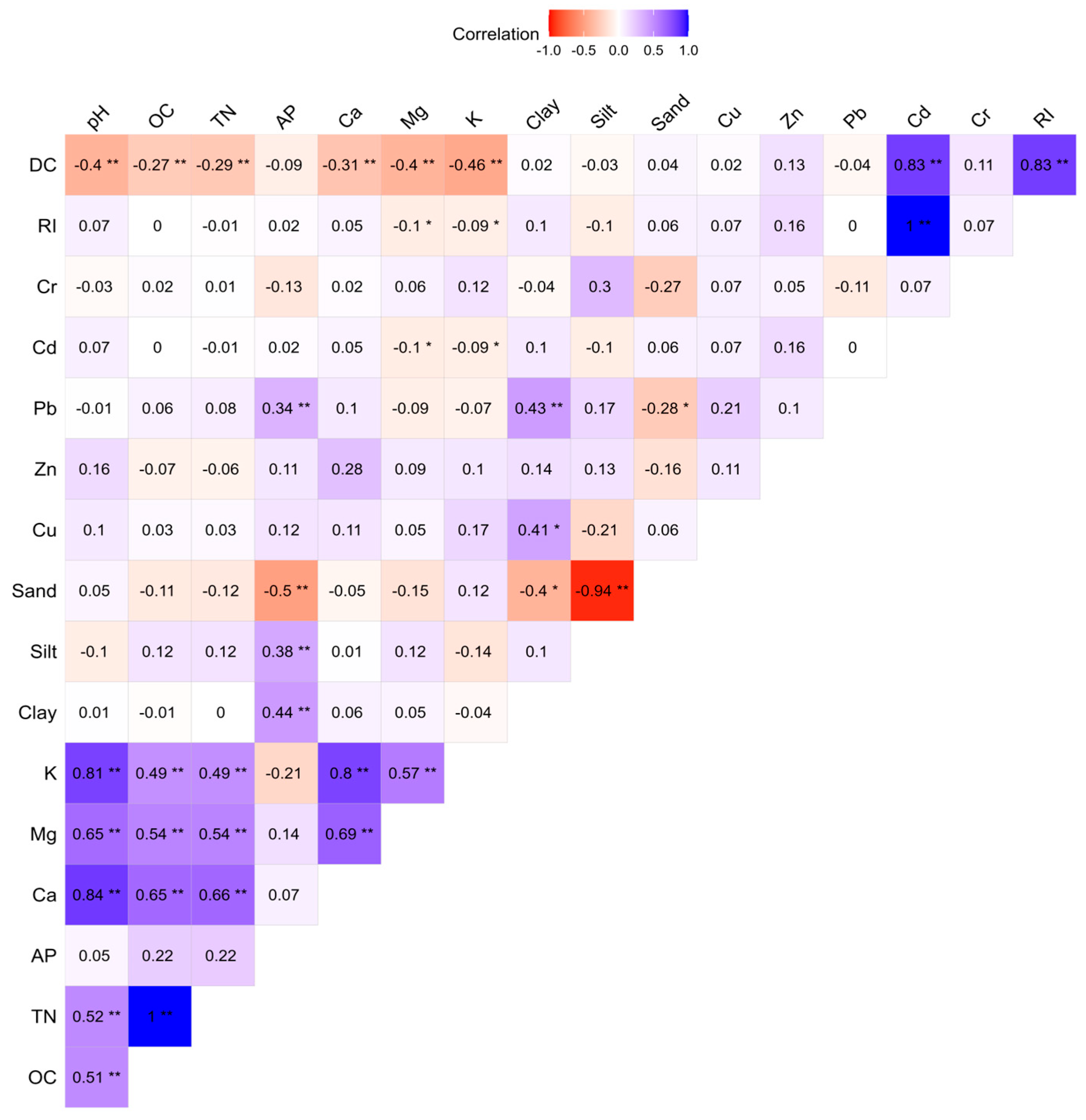
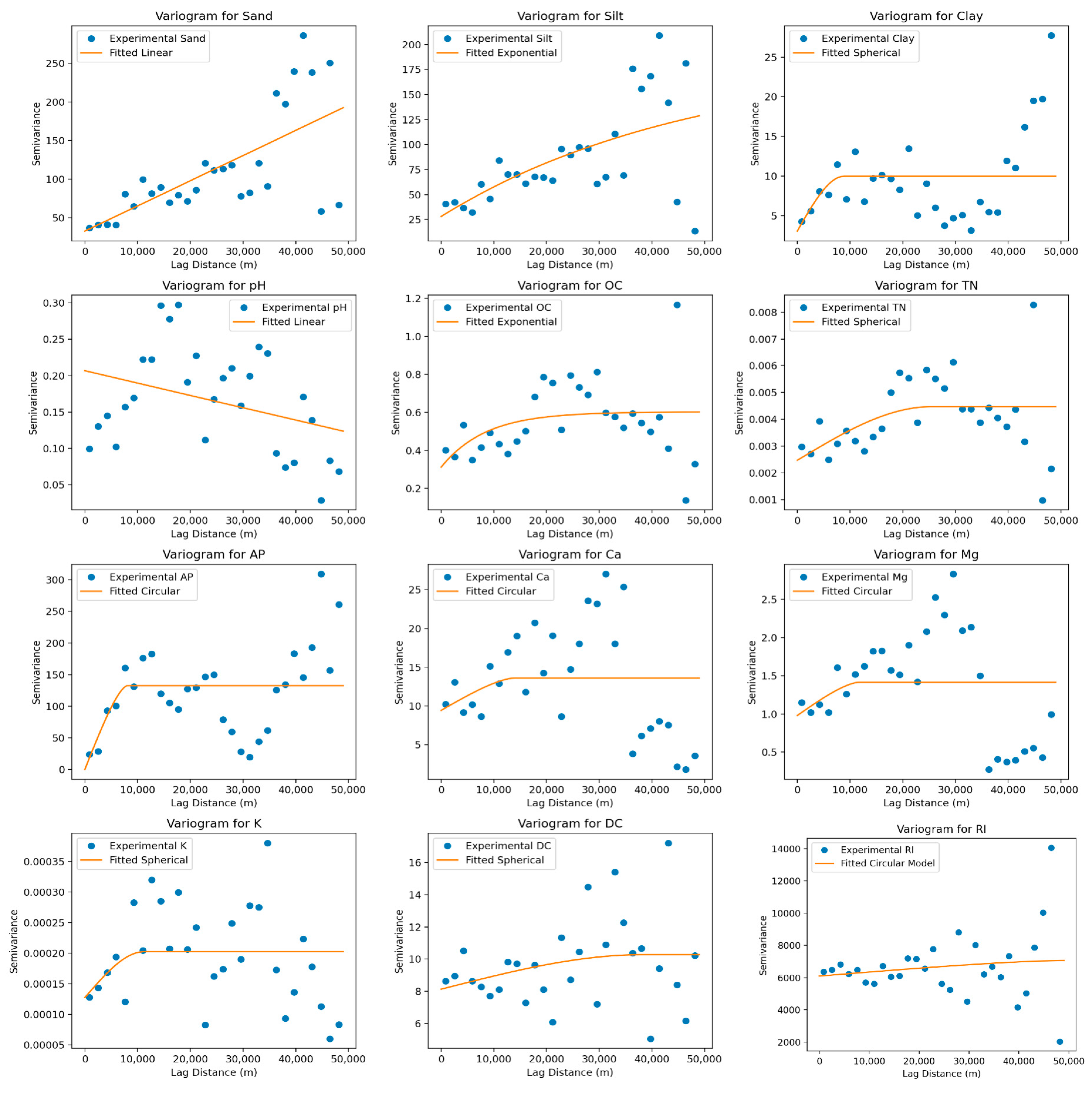
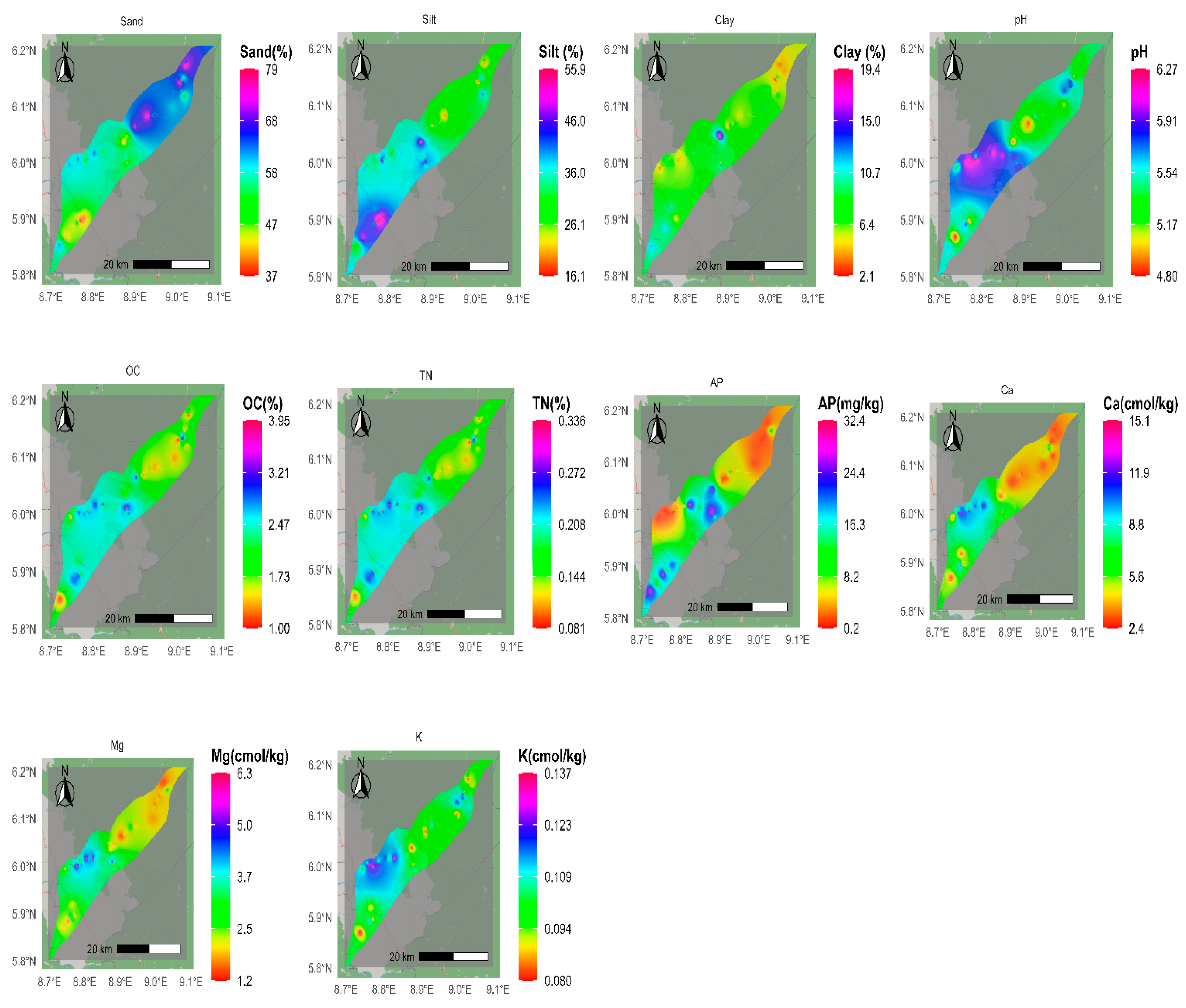
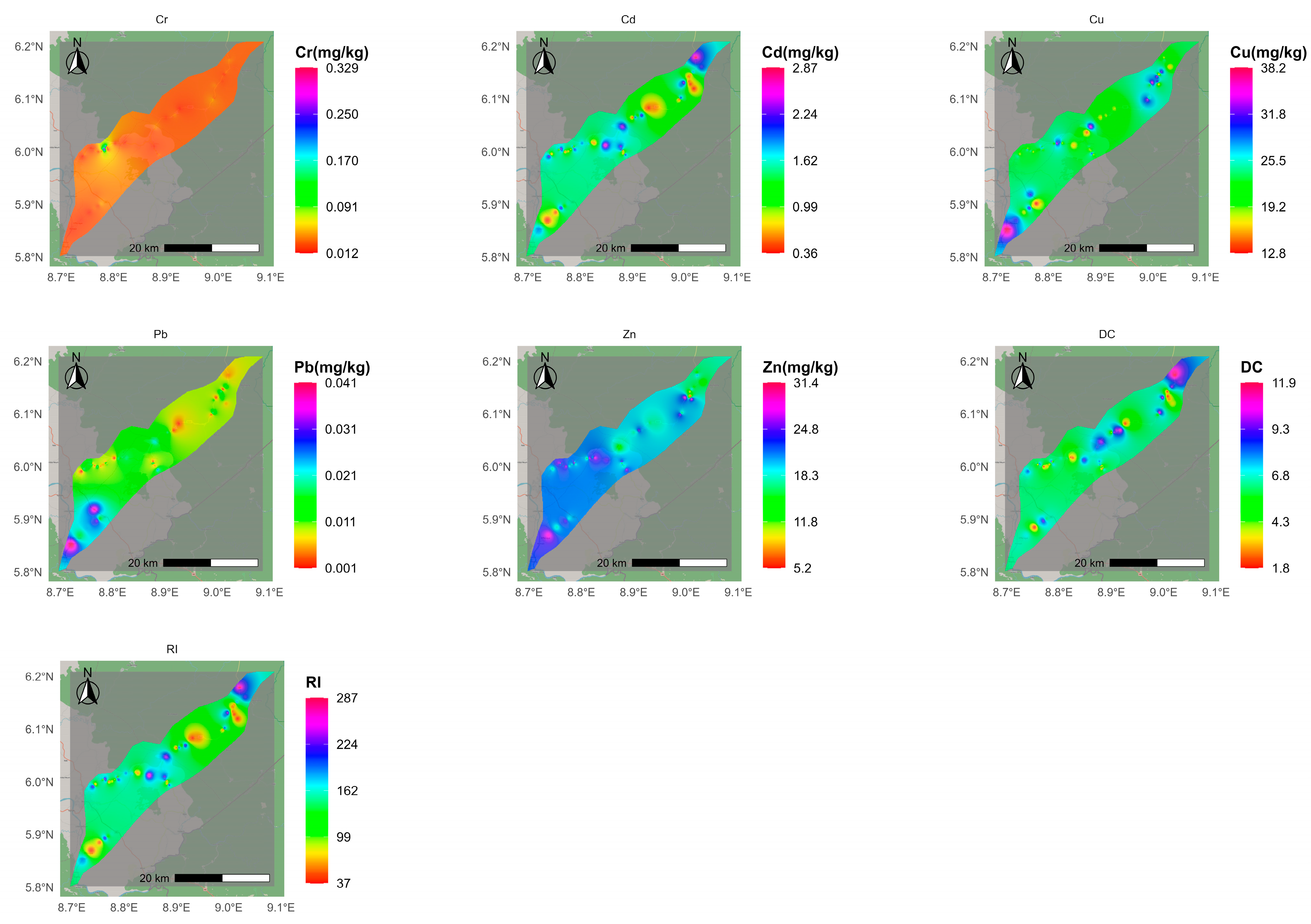
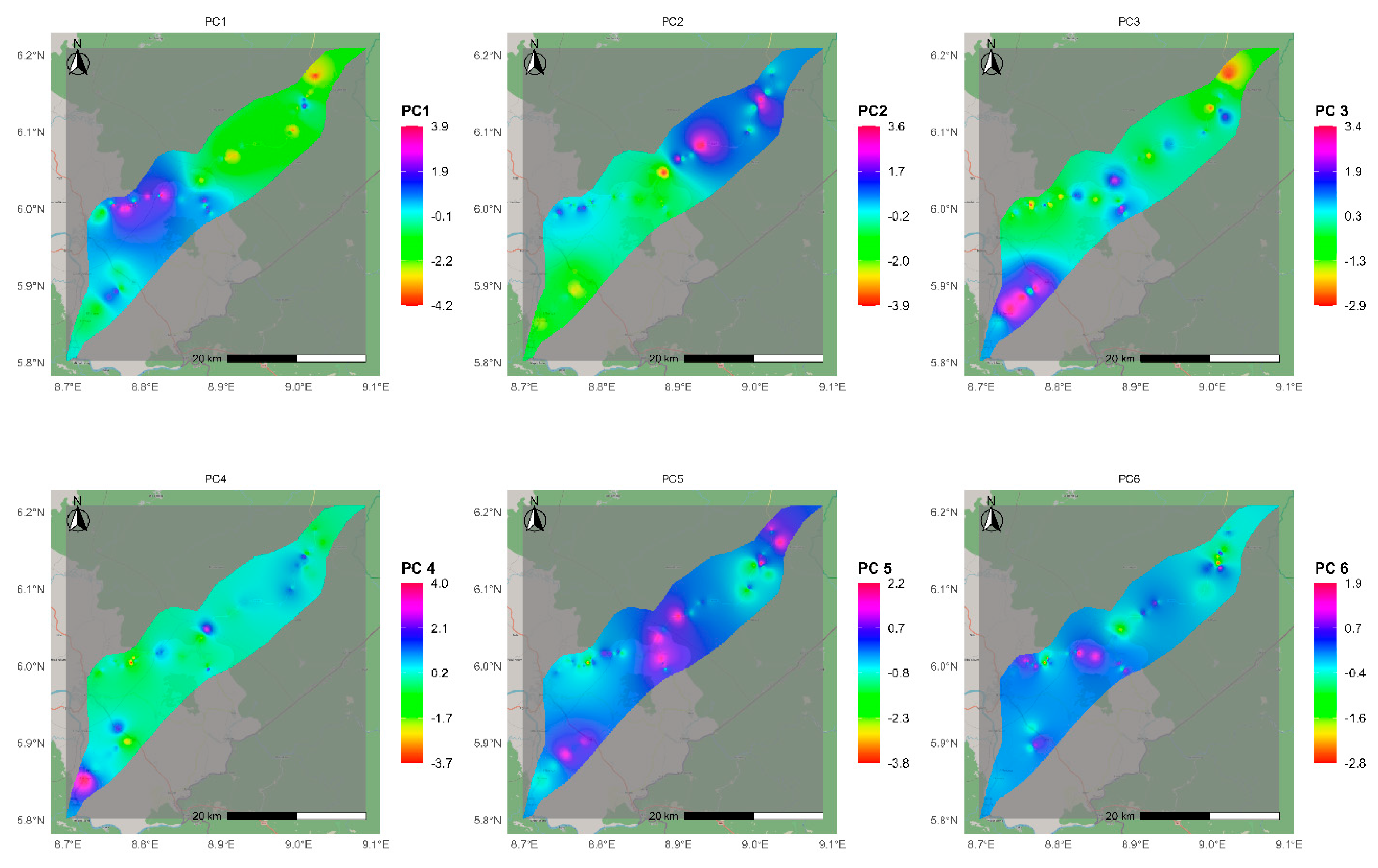
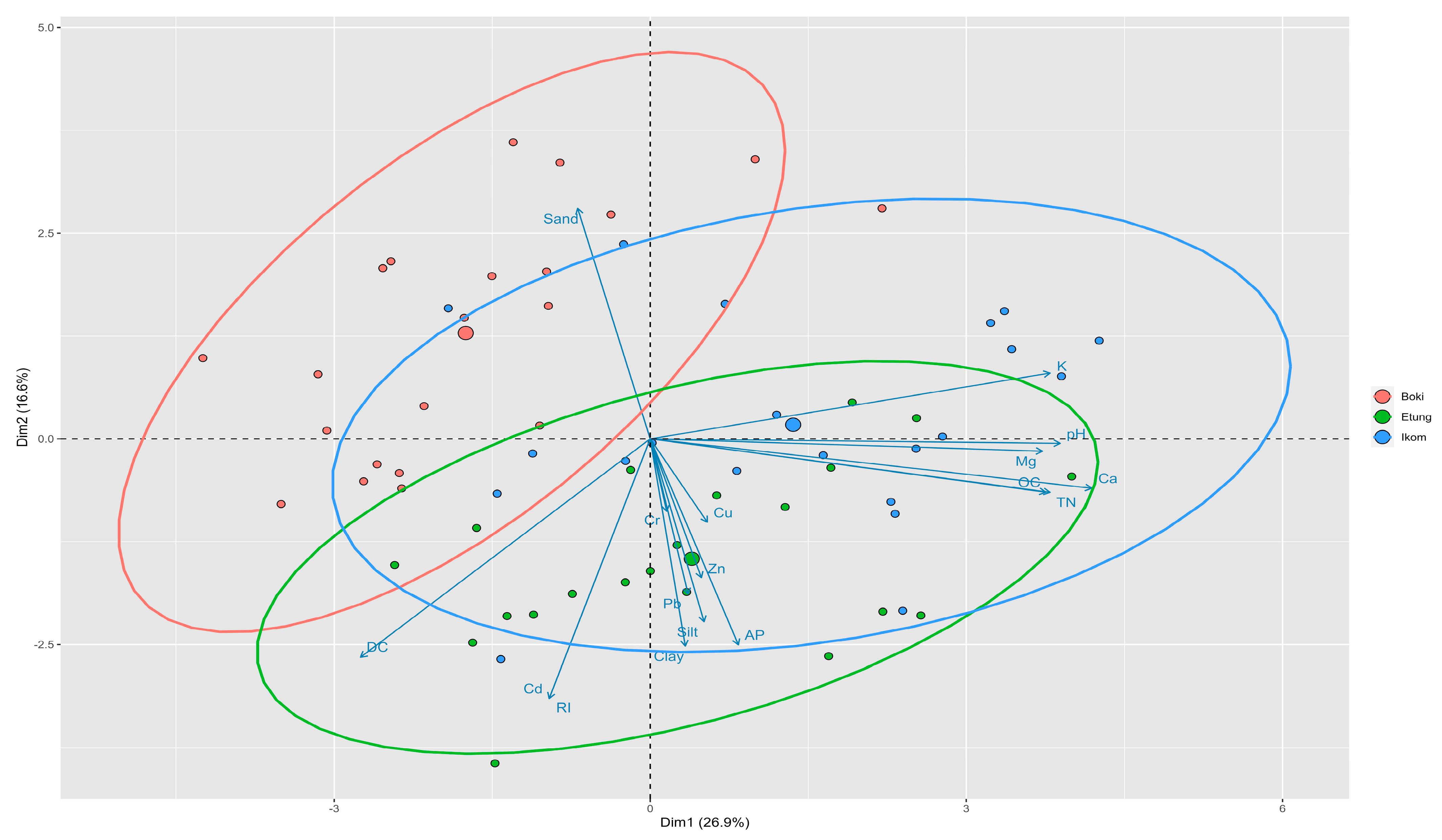


| Mean | Min | Max | SD | CV (%) | Skewness | Kurtosis | KS p-Value | |
|---|---|---|---|---|---|---|---|---|
| Sand (%) | 58.35 | 36.6 | 79.00 | 9.05 | 15.51 | −0.09 | −0.04 | 0.90 |
| Silt (%) | 34.75 | 16.00 | 56.00 | 8.24 | 23.72 | 0.38 | 0.27 | 0.42 |
| Clay (%) | 7.01 | 2.00 | 19.40 | 2.84 | 40.51 | 1.62 | 4.95 | 0.13 |
| pH | 5.62 | 4.80 | 6.30 | 0.43 | 7.71 | −0.21 | −1.09 | 0.30 |
| OC (%) | 2.22 | 0.92 | 4.00 | 0.73 | 32.83 | 0.24 | −0.56 | 0.93 |
| TN (%) | 0.19 | 0.08 | 0.34 | 0.06 | 32.72 | 0.23 | −0.58 | 0.80 |
| AP (mgkg−1) | 8.71 | 0.12 | 32.75 | 10.27 | 117.84 | 0.81 | −0.9 | 0.00 |
| Ca (cmolkg−1) | 6.5 | 2.40 | 16.80 | 3.86 | 59.49 | 0.93 | −0.11 | 0.12 |
| Mg (cmolkg−1) | 2.89 | 1.20 | 6.40 | 1.25 | 43.18 | 0.89 | −0.07 | 0.03 |
| K (cmolkg−1) | 0.11 | 0.08 | 0.14 | 0.01 | 13.77 | 0.27 | −0.33 | 0.02 |
| Cu (mgkg−1) | 23.23 | 12.76 | 38.19 | 6.38 | 27.47 | 0.62 | −0.79 | 0.11 |
| Zn (mgkg−1) | 20.69 | 5.10 | 36.21 | 5.24 | 25.3 | 0.03 | 0.85 | 0.54 |
| Pb (mgkg−1) | 0.01 | 0.00 | 0.04 | 0.01 | 70.78 | 0.93 | 1.14 | 0.27 |
| Cd (mgkg−1) | 1.41 | 0.18 | 2.87 | 0.80 | 57.09 | 0.02 | −1.54 | 0.06 |
| Cr (mgkg−1) | 0.03 | 0.01 | 0.34 | 0.05 | 160.78 | 5.16 | 25.38 | 0.00 |
| DC | 6.17 | 1.65 | 11.93 | 3.04 | 49.28 | 0.08 | −1.12 | 0.41 |
| RI | 140.84 | 18.24 | 287.15 | 80.37 | 57.06 | 0.02 | −1.54 | 0.06 |
| Variables | Model | Nugget (C0) | Partial Sill (C1) | Sill (C0+C1) | Range (m) | Nugget/Sill | Spatial Dependency | ME | MAE | RMSE |
|---|---|---|---|---|---|---|---|---|---|---|
| Sand | Linear | 34.54 | 47.4 | 81.94 | 13,746.57 | 0.42 | Moderate | −1.58 | 6.83 | 8.59 |
| Silt | Exponential | 5.01 | 67.89 | 72.89 | 100.00 | 0.07 | Strong | 1.01 | 6.08 | 8.08 |
| Clay | Spherical | 3.27 | 6.48 | 9.75 | 9675.82 | 0.33 | Moderate | −0.50 | 2.06 | 2.86 |
| pH | Linear | 0.01 | 0.14 | 0.149 | 857.63 | 0.06 | Strong | −0.03 | 0.26 | 0.32 |
| OC | Exponential | 0.00 | 0.44 | 0.44 | 274.81 | 0.00 | Strong | −0.06 | 0.62 | 0.71 |
| TN | Spherical | 0.00 | 0.00 | 0.00 | 1661.71 | 0.74 | Moderate | −0.00 | 0.049 | 0.06 |
| AP | Circular | 50.00 | 105.46 | 155.46 | 950.00 | 0.32 | Moderate | 0.39 | 6.88 | 8.26 |
| Ca | Circular | 8.34 | 2.31 | 10.65 | 885.52 | 0.78 | Weak | −0.04 | 2.97 | 3.56 |
| Mg | Circular | 0.08 | 1.24 | 1.315 | 846.95 | 0.06 | Strong | −0.05 | 0.96 | 1.19 |
| K | Spherical | 6.80 | 7.47 × 10−5 | 6.80 | 709.04 | 0.10 | Weak | 6.77 × 10−5 | 0.01 | 0.01 |
| Zn | Linear | 5.74 | 22.09 | 27.83 | 868.98 | 0.21 | Strong | −0.04 | 4.55 | 5.73 |
| Cu | Linear | 3.25 | 38.89 | 42.14 | 788.15 | 0.08 | Strong | −0.07 | 5.85 | 7.03 |
| Pb | Spherical | 1.65 × 10−8 | 6.27 × 10−5 | 6.27 × 10−5 | 1014.29 | 0.00 | Strong | −0.00 | 0.01 | 0.01 |
| Cd | Circular | 0.15 | 0.53 | 0.68 | 1213.77 | 0.22 | Strong | 0.03 | 0.77 | 0.86 |
| Cr | Spherical | 0.00 | 0.00 | 0.00 | 1200.86 | 0.07 | Strong | −0.01 | 0.01 | 0.02 |
| DC | Spherical | 2.29 | 7.29 | 9.58 | 893.12 | 0.24 | Strong | 0.09 | 2.65 | 3.13 |
| RI | Circular | 1876.43 | 4595.20 | 6471.63 | 262.26 | 0.29 | Moderate | 1.13 | 73.72 | 81.52 |
| PC 1 | PC 2 | PC 3 | PC 4 | PC 5 | PC 6 | |
|---|---|---|---|---|---|---|
| eigenvalue | 4.575 | 2.822 | 2.732 | 1.691 | 1.318 | 1.027 |
| Variance (%) | 26.914 | 16.602 | 16.069 | 9.949 | 7.753 | 6.044 |
| CV (%) | 26.914 | 43.516 | 59.585 | 69.534 | 77.287 | 83.331 |
| Soil properties | ||||||
| pH | 0.880 | −0.023 | −0.126 | 0.025 | 0.194 | −0.03 |
| OC | 0.794 | 0.048 | 0.190 | 0.018 | −0.481 | −0.093 |
| TN | 0.798 | 0.035 | 0.196 | 0.027 | −0.471 | −0.107 |
| AP | 0.078 | 0.026 | 0.567 | 0.462 | −0.081 | −0.384 |
| Ca | 0.935 | 0.014 | 0.000 | 0.069 | 0.166 | −0.019 |
| Mg | 0.780 | −0.143 | 0.138 | −0.022 | 0.053 | 0.042 |
| K | 0.837 | −0.169 | −0.249 | 0.003 | 0.141 | 0.232 |
| Clay | −0.007 | 0.055 | 0.201 | 0.816 | 0.104 | −0.039 |
| Silt | −0.002 | −0.065 | 0.944 | −0.038 | 0.049 | 0.168 |
| Sand | −0.021 | 0.051 | −0.927 | −0.216 | −0.092 | −0.145 |
| Cu | 0.092 | 0.034 | −0.307 | 0.763 | 0.000 | 0.313 |
| Zn | 0.169 | 0.165 | 0.156 | 0.098 | 0.812 | −0.037 |
| Pb | −0.012 | −0.021 | 0.226 | 0.639 | 0.011 | −0.244 |
| Cd | 0.037 | 0.983 | −0.049 | 0.045 | 0.066 | 0.010 |
| Cr | 0.036 | 0.084 | 0.249 | −0.054 | −0.022 | 0.888 |
| RI | 0.037 | 0.983 | −0.049 | 0.045 | 0.066 | 0.010 |
| DC | −0.384 | 0.885 | 0.000 | −0.031 | 0.039 | 0.083 |
| Exchangeable Cations | Particle Size Fractions | Heavy Metals | |||||||||||||||
|---|---|---|---|---|---|---|---|---|---|---|---|---|---|---|---|---|---|
| MZs | pH | OC | TN | AP | Ca | Mg | K | Clay | Silt | Sand | Cu | Zn | Pb | Cd | Cr | RI | DC |
| MZ1 | 5.57 b | 2.12 b | 0.18 b | 17.32 a | 5.23 b | 2.55 b | 0.10 b | 8.39 a | 40.13 a | 51.46 b | 22.05 a | 21.41 a | 0.02 a | 1.48 a | 0.02 a | 148.52 a | 5.97 ab |
| MZ2 | 5.20 c | 1.68 c | 0.14 c | 3.77 c | 3.07 c | 1.97 b | 0.10 b | 5.95 b | 32.22 b | 62.31 a | 22.53 a | 19.89 a | 0.01 b | 1.33 a | 0.04 a | 132.67 a | 7.53 a |
| MZ3 | 6.06 a | 2.79 a | 0.24 a | 7.72 b | 10.62 a | 4.01 a | 0.12 a | 7.11 ab | 33.58 b | 59.16 a | 24.69 a | 20.98 a | 0.01 b | 1.43 a | 0.04 a | 143.55 a | 5.00 b |
| Soil MZs | Area (Ha) | % |
|---|---|---|
| MZ1 | 14,115.4 | 27.7 |
| MZ2 | 20,703.1 | 40.6 |
| MZ3 | 16,173.2 | 31.7 |
Disclaimer/Publisher’s Note: The statements, opinions and data contained in all publications are solely those of the individual author(s) and contributor(s) and not of MDPI and/or the editor(s). MDPI and/or the editor(s) disclaim responsibility for any injury to people or property resulting from any ideas, methods, instructions or products referred to in the content. |
© 2025 by the authors. Licensee MDPI, Basel, Switzerland. This article is an open access article distributed under the terms and conditions of the Creative Commons Attribution (CC BY) license (https://creativecommons.org/licenses/by/4.0/).
Share and Cite
Isong, I.A.; Olim, D.M.; Nwachukwu, O.I.; Onwuka, M.I.; Afu, S.M.; Otie, V.O.; Oko, P.E.; Heung, B.; John, K. Delineating Soil Management Zones for Site-Specific Nutrient Management in Cocoa Cultivation Areas with a Long History of Pesticide Usage. Land 2025, 14, 1366. https://doi.org/10.3390/land14071366
Isong IA, Olim DM, Nwachukwu OI, Onwuka MI, Afu SM, Otie VO, Oko PE, Heung B, John K. Delineating Soil Management Zones for Site-Specific Nutrient Management in Cocoa Cultivation Areas with a Long History of Pesticide Usage. Land. 2025; 14(7):1366. https://doi.org/10.3390/land14071366
Chicago/Turabian StyleIsong, Isong Abraham, Denis Michael Olim, Olayinka Ibiwumi Nwachukwu, Mabel Ifeoma Onwuka, Sunday Marcus Afu, Victoria Oko Otie, Peter Ereh Oko, Brandon Heung, and Kingsley John. 2025. "Delineating Soil Management Zones for Site-Specific Nutrient Management in Cocoa Cultivation Areas with a Long History of Pesticide Usage" Land 14, no. 7: 1366. https://doi.org/10.3390/land14071366
APA StyleIsong, I. A., Olim, D. M., Nwachukwu, O. I., Onwuka, M. I., Afu, S. M., Otie, V. O., Oko, P. E., Heung, B., & John, K. (2025). Delineating Soil Management Zones for Site-Specific Nutrient Management in Cocoa Cultivation Areas with a Long History of Pesticide Usage. Land, 14(7), 1366. https://doi.org/10.3390/land14071366






